Marketers love email because it works – researchers tell us that open rates, click rates and, most importantly, conversion rates are up and are driving ROI . . . proving that consumers also love it. Yet, surprisingly, some companies are not using this channel well enough to make the most of email campaign opportunities. Guy Hanson has a handful of ways to boost your brand’s email performance. Check them out:
With an average return on investment (ROI) of £32.28 for every pound spent, email is one of the top channels for marketers to connect with customers and build valuable relationships. In fact, 63 per cent of consumers prefer email for brand communications. Building an optimised email programme requires marketers to incorporate certain key email campaigns designed to keep customers engaged throughout the subscriber lifecycle. For example, triggered birthday messages allow a brand to create a personalised relationship with each email subscriber and strengthen brand loyalty.
Maximising email campaign opportunities
Here are examples of five emails that can help improve subscriber engagement and boost the performance of email campaigns.
1. Account related messages
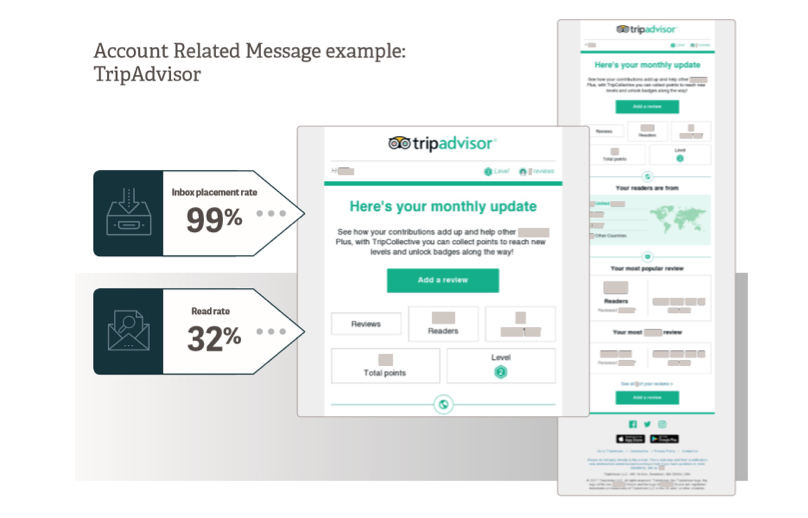
Account related messages are sent to notify subscribers of a change or activity related to their account. These emails are meant to keep subscribers informed rather than generate revenue. As such, they see relatively high engagement, with an average read rate of 30 per cent and a deleted-before-reading rate of just nine per cent.
As an example, TripAdvisor sends online reviewers a monthly account update with a digest of stats related to their recent posts. These have an inbox placement rate of 99 per cent, indicating that this user is trusted and the content is welcomed by the subscriber.
2. Birthday messages
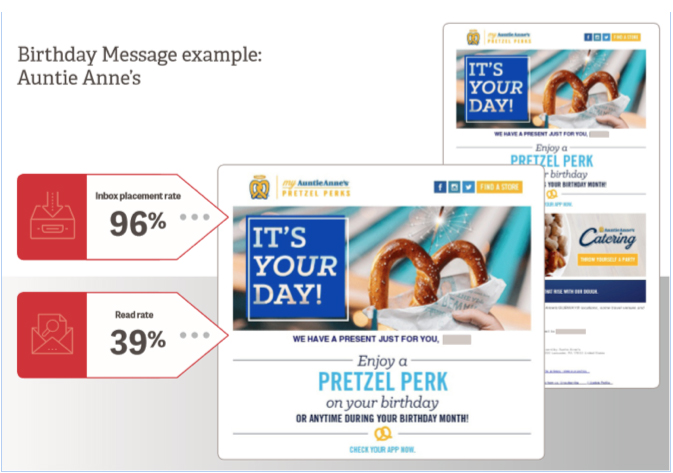
‘Happy birthday’ emails – and accompanying discounts – provide marketers with an annual opportunity to boost sales while also building a personal connection with their customers. According to our research, birthday messages generate relatively high engagement with a read rate of 23 per cent. These messages were also frequently retrieved from the spam folder, with a ‘this is not spam’ rate of 2.29 per cent.
An example of a good birthday programme is Auntie Anne’s, which sends members of their ‘pretzel perk programme’ a special birthday email, promoting a free pretzel in the subject line to capture subscriber attention and drive engagement. The creative uses eye catching images and large, bold text to convey the birthday message and offer, which results in a 39 per cent read rate.
3. Loyalty programme messages
Loyalty programme messages are campaigns sent to select subscribers who participate in the brand’s loyalty scheme. Both the loyalty programme itself and related messages are designed to create a sense of exclusivity and inform the reader of additional benefits. Metrics indicate that customers appreciate this exclusive treatment, as loyalty programme messages see a read rate that is two per cent higher than that of general promotional messages (21 per cent v 19 per cent).
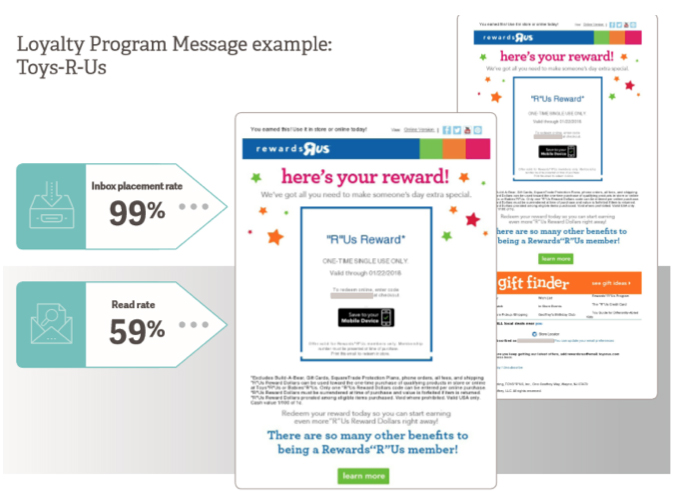
For example, through a Toys R Us loyalty programme, members could earn cash rewards to use on future purchases. The email used a simple subject line and mobile friendly design to convey its message and, within the email, a link allowed the customer to save the coupon on their mobile device — a great feature that makes it easy and convenient to locate the coupon when people are ready to use it, rather than searching back through their inbox. This Toys R Us email campaign saw a 59 per cent read rate and a 99 per cent inbox placement rate.
4. Post purchase messages
Post purchase emails are a type of transaction email that provides details of the completed purchase, including order confirmations and receipts. As the messages contain essential information, this campaign type has the highest average read rate (44 per cent) and the lowest average deleted-before-reading rate (seven per cent) of any category analysed. While order confirmation emails typically have strong subscriber engagement, they tend to get overlooked by marketers.
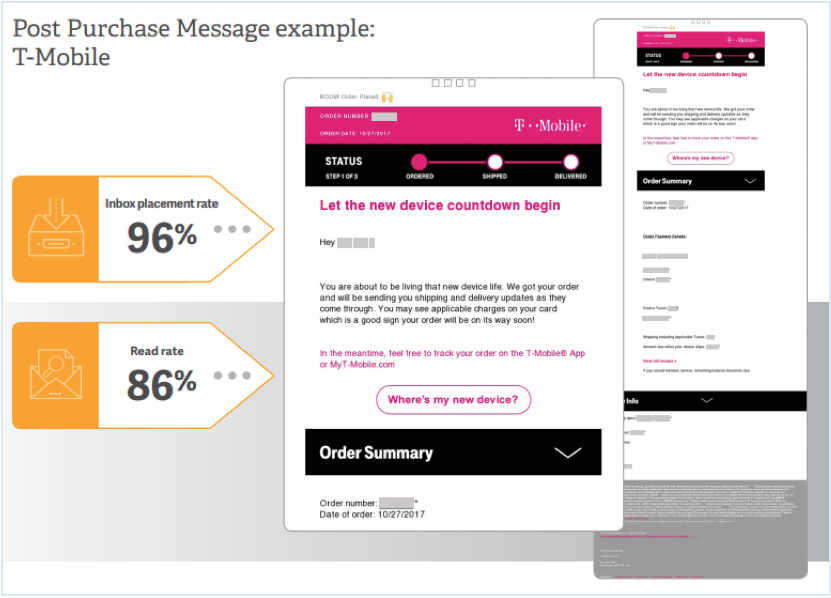 T-Mobile is a good example of how to do the post purchase message right. Aside from being well branded, the clean design is mobile friendly, which is critical for a target audience likely to view the message on a mobile device. Order status is represented with an easy to understand three-step visual within the preview pane. Beyond simple first name personalisation, T-Mobile demonstrates good customer service by letting the subscriber know they will receive ‘shipping and delivery updates as they come through’, while also encouraging tracking via the T-Mobile app. The content of the email is well organised, with detailed sections for ‘Order Summary’ and ‘Delivery Info’.
T-Mobile is a good example of how to do the post purchase message right. Aside from being well branded, the clean design is mobile friendly, which is critical for a target audience likely to view the message on a mobile device. Order status is represented with an easy to understand three-step visual within the preview pane. Beyond simple first name personalisation, T-Mobile demonstrates good customer service by letting the subscriber know they will receive ‘shipping and delivery updates as they come through’, while also encouraging tracking via the T-Mobile app. The content of the email is well organised, with detailed sections for ‘Order Summary’ and ‘Delivery Info’.
5. Win back messages
Sometimes, subscribers become distant and stop interacting with messages. Before they disengage entirely by unsubscribing – or worse, complaining – marketers have one last option to re-engage subscribers before they decide to leave – a win back campaign. Win back emails saw an average read rate of 20 per cent last year – which means one out of five subscribers who were previously ignoring messages may be inspired to re-engage. These campaigns are also helpful for identifying and removing inactive addresses from a list to prevent list hygiene issues from damaging deliverability.
An example of a good win back message is Kate Spade’s campaign, in which it appealed to subscribers’ FOMO (fear of missing out) by highlighting missed new products and popular categories. The pre-header text promoted an exclusive, limited time offer to prompt subscribers to re-engage, which is repeated within the email message. These emails had a high read rate of 40 per cent.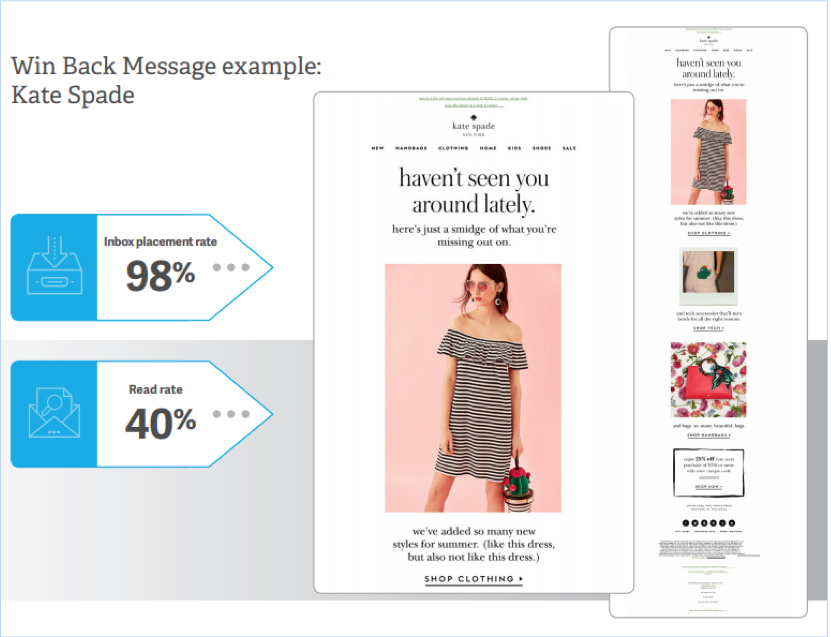
Building an optimised email programme requires marketers to incorporate certain key email campaigns designed to keep customers engaged throughout the subscriber lifecycle. It can be difficult for marketers to evaluate an email campaign’s performance objectively, as goals and expectations can vary for different types of email campaigns. But, if they harness some of these five email marketing campaigns, companies will have a much better chance of maintaining and growing email engagement levels, growing a subscriber list and boosting overall email marketing performance.
Have an opinion on this article? Please join in the discussion: the GMA is a community of data driven marketers and YOUR opinion counts.




 T-Mobile is a good example of how to do the post purchase message right. Aside from being well branded, the clean design is mobile friendly, which is critical for a target audience likely to view the message on a mobile device. Order status is represented with an easy to understand three-step visual within the preview pane. Beyond simple first name personalisation, T-Mobile demonstrates good customer service by letting the subscriber know they will receive ‘shipping and delivery updates as they come through’, while also encouraging tracking via the T-Mobile app. The content of the email is well organised, with detailed sections for ‘Order Summary’ and ‘Delivery Info’.
T-Mobile is a good example of how to do the post purchase message right. Aside from being well branded, the clean design is mobile friendly, which is critical for a target audience likely to view the message on a mobile device. Order status is represented with an easy to understand three-step visual within the preview pane. Beyond simple first name personalisation, T-Mobile demonstrates good customer service by letting the subscriber know they will receive ‘shipping and delivery updates as they come through’, while also encouraging tracking via the T-Mobile app. The content of the email is well organised, with detailed sections for ‘Order Summary’ and ‘Delivery Info’.



Leave your thoughts